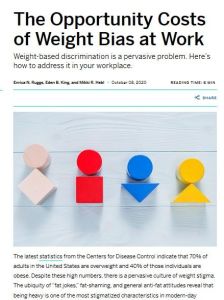
Enrica N. Ruggs, Eden B. King and Mikki R. Hebl
The Opportunity Costs of Weight Bias at Work
Weight-based discrimination is a pervasive problem. Here’s how to address it in your workplace.
MIT Sloan Management Review, 2020
What's inside?
Learn to recognize and reduce weight-based bias in the workplace.
Recommendation
Harvard research shows that racial and gender bias have abated over the past decade – but one form of bias is increasing: weight-based bias. To help managers understand the prevalence and negative impacts of weight discrimination, MIT Sloan Management Review offers a concise article from three experts in management and psychology. Enrica N. Ruggs is director of the Center for Workplace Diversity and Inclusion at the University of Memphis, Eden B. King is professor of psychology at Rice University, and Mikki R. Hebl is professor of psychology and management at Rice.
Take-Aways
- Although many people are overweight in the United States, weight still carries a stigma.
- Weight bias can lead to discrimination in employment practices, including in hiring, performance evaluations and training.
- Weight bias can undermine an organization’s performance.
- Managers can take steps to reduce the effects of weight bias in their organizations.
Summary
Although many people are overweight in the United States, weight still carries a stigma.
Nearly three out of four Americans qualify as overweight – but in spite of its prevalence, being overweight or obese exposes people to bias, discrimination and inequality.
“Being heavy is one of the most stigmatized characteristics in modern-day society.”
The stigma arises because many people blame overweight people, erroneously believing anyone could maintain a healthy weight through exercise and diet. They attribute laziness, lack of intelligence, and weak willpower to overweight individuals – as well as stereotypes such as introversion and emotional instability. In reality, factors other than willpower – some genetic – determine a person’s weight.
Weight bias can lead to discrimination in employment practices, including in hiring, performance evaluations and training.
Weight-based bias leads to many varieties of discrimination in the workplace. In one study, interviewers spent less time with job applicants who appeared to be obese. They also smiled and nodded less. Research shows that hiring managers’ implicit negative attitudes about weight affected who they invited for job interviews.
“Even CEOs, senior vice presidents and board members are susceptible to the effects of weight bias and discrimination.”
Among senior managers, body size showed a negative correlation with the performance evaluations they received. And research shows employees’ weight can significantly affect their wages – particularly for female employees.
Weight bias can undermine an organization’s performance.
Weight-based bias affects organizations as well as individuals. Organizations where weight bias affects employee selection or promotion fail to tap employees’ full potential. And discrimination can negatively affect workers’ well-being, attitudes and outcomes. Research shows that salespeople tend to treat overweight shoppers differently from thinner shoppers. When customers perceive bias in the way salespeople treat them, they tend to spend less and are less likely to return.
Managers can take steps to reduce the effects of weight bias in their organizations.
Managers can reduce weight bias and its negative effects by, first, becoming aware of their own biases and how those may translate into mistreatment or discrimination. Second, managers can reduce bias and discrimination in HR decision making by implementing anchored rating scales and other standardized, objective measures. Also, ensuring that multiple decision makers contribute to personnel decisions can reduce the effects of bias and improve accountability. Finally, managers can reduce bias and discrimination among their subordinates by ensuring that antidiscrimination policies and training include weight bias. They can also educate workers about the causes of becoming overweight, send messages that emphasize the organization’s commitment to antidiscrimination, and model inclusive, nondiscriminatory behaviors.
About the Authors
Enrica N. Ruggs is an assistant professor of management and director of the Center for Workplace Diversity and Inclusion at the Fogelman College of Business and Economics at the University of Memphis. Eden B. King is the Lynette S. Autrey Professor of Psychology at Rice University. Mikki R. Hebl is the Martha and Henry Malcolm Lovett Professor of Psychology and a professor of management at Rice University.
This document is restricted to personal use only.
My Highlights
Did you like this summary?
Read the articleThis summary has been shared with you by getAbstract.
We find, rate and summarize relevant knowledge to help people make better decisions in business and in their private lives.
Already a customer? Log in here.

















Comment on this summary